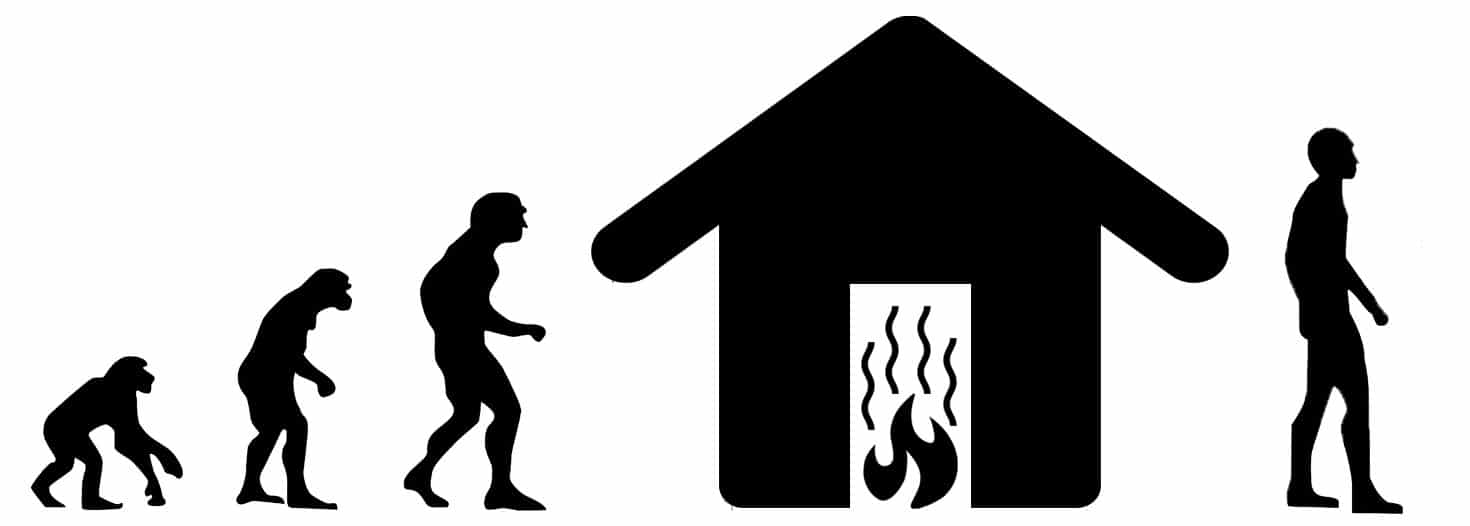To Sweat Is Human: To Sauna, Divine
The story of human perspiration goes back to the very beginning of our existence. Anthropologists suggest that this unique quality of our skin membrane is the single most significant factor in our evolution and eventual rise to master of the animal kingdom. This unique quality of the human skin membrane, the largest organ in the body, and its ability to perspire altered the projected history of our planet forever.
Human beings have cherished perspiration from the skin membrane since before recorded history by manufacturing units of controlled heat to induce sweating for spiritual, medical and social reasons. Evidence suggests as humans evolved and found homes in all areas of the planet; they built varying systems to intentionally encourage copious sweating.
Collectively, human beings are bonded throughout time and space by our desire to maximize the function of perspiration, to find commune with a higher power, and to optimize our health. While units of controlled heat designed to induce sweating have varied from culture to culture and have naturally evolved over thousands of years, they have remained fundamentally the same in their purpose.
Perspiration Defines Human Kind
The human body is an exquisite machine, honed over millions of years of evolution. Many believe the human status as alpha primates results from being an upright species with larger brain size, but there is a key element in the human evolution that often goes overlooked: the skin membrane. A slight variance in the human genome, causing mostly naked skin, differentiates us from our closest relative, the chimpanzee.
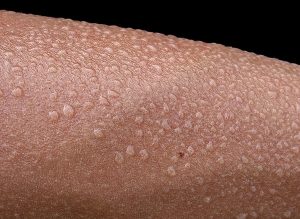 Professor Nina Jablonski, of Pennsylvania State University, studies the evolution of human skin; she suggests that the human sweat glands are singularly responsible for making human beings the superior hunter. The unique property of sweating enabled the first human hunters to cool their body as they chased their prey. Four-legged creatures cool their bodies through panting and as the animals begin to gallop their internal organs slam against the diaphragm. This means four-legged animals cannot cool their bodies through panting as they run. Eventually, the hunted prey will overheat and die, while its human predator, who is able to regulate internal heat through sweating, will achieve victory and ultimately a steady food supply.
Professor Nina Jablonski, of Pennsylvania State University, studies the evolution of human skin; she suggests that the human sweat glands are singularly responsible for making human beings the superior hunter. The unique property of sweating enabled the first human hunters to cool their body as they chased their prey. Four-legged creatures cool their bodies through panting and as the animals begin to gallop their internal organs slam against the diaphragm. This means four-legged animals cannot cool their bodies through panting as they run. Eventually, the hunted prey will overheat and die, while its human predator, who is able to regulate internal heat through sweating, will achieve victory and ultimately a steady food supply.
The integrated network of human sweat glands and a mostly naked and furless skin membrane catapults human evolution to the next level. As human beings spread out from the motherland of Africa to occupy the vast lands of planet Earth, they begin to develop technologies to enhance the natural perspiration occurring in the body, creating optimal health, purification, and spiritual communion.
Sauna: The Etymology
Sauna is a contemporary term used to describe any heating system intended to create profuse sweating. Sauna is the only word in the English dictionary with its roots in the Finnish language. ‘Sauna’ (pronounced: saw-na) means bathhouse in Finnish. Many languages have borrowed the Finnish word, Sauna, to describe manufactured units of heating. While Finland is by no means the only country to use heat therapy, it does have a tradition that has been a landmark of their culture as far back as 7000 BC.
The colloquial use of the term sauna in English does not specifically refer to the heating structures used in Finland, but rather the general structure that intends to heat the body and produce intense sweating.
Stoking the Fire: The First Saunas
As humans developed the ability to make fire at will, the first ‘Saunas’ were built. Fire not only allowed our ancestors to cook their food, but it also brought with it the means to intentionally heat the body. The first Saunas built in Africa were developed to rid the body of infectious disease. While rudimentary in their structures, the methodology was effective.
Tribal medicine leaders dug holes in the ground, roughly the size of a grave, to comfortably fit the human body. A fire was built inside the hole, as the fire turned to hot coals, poles were laid over the opening of the area to create a bed-like structure. The patient suffering from infectious disease was placed on the bed of poles elevated three feet above the hot coals and kept there until profuse sweating occurred. The purification process through perspiration was successful at ridding patients of many diseases.
Far from the upscale saunas found in spas of developed countries today, the design of the first heat therapy developed in East Africa had the same intention. Clearly, human beings have used the specific technology at their disposal to create heat structures with the motivation of inducing profuse sweating, to cure disease, and optimize health.
The Finnish Sauna
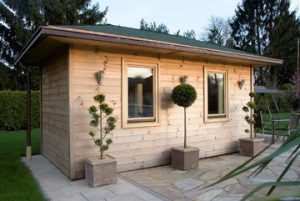 To explore the history of Saunas one must gaze upon the great Finnish tradition of sauna use thought to date back as far as 7000 BC. For residents of Finland, a sauna is not a luxury but rather a necessity. There is on average one sauna per household (There are 3 million saunas in Finland serving a population of 5 million). Most dry heat saunas found in developed countries today are based on the modern construction of the Finish archetype.
To explore the history of Saunas one must gaze upon the great Finnish tradition of sauna use thought to date back as far as 7000 BC. For residents of Finland, a sauna is not a luxury but rather a necessity. There is on average one sauna per household (There are 3 million saunas in Finland serving a population of 5 million). Most dry heat saunas found in developed countries today are based on the modern construction of the Finish archetype.
Before the prevalent allopathic medical system, almost all Finnish babies were born in the sauna. A sauna is even located in the Finnish Parliament House. From birth to important political decisions, saunas are the canvas upon which the Finnish story has been painted.
The earliest known sauna structures date back 2000 years and were dug into the earth and lined with stone. The structure of saunas in Finland has evolved substantially over thousands of years. Traditionally, stones are heated up in the fire and water is poured on them to create steam and heat.
Saunas are heated with hot stones, wood stoves, hot embers, and electricity. Typically the structures are made of wood, as trees are in great abundance in the Baltic States. The Savusauna, or smoke sauna, takes place inside an unventilated space. A fire is stoked and once the flames burn out, smoke is released from the room and individuals can step inside to enjoy the emanating heat. Finnish sauna connoisseurs consider this version of the sauna to be the most effective.
Sauna therapy is the cornerstone of Finnish culture. The country’s reverence for its health benefits, tradition and community support have made it among the world leaders in sauna therapy.
The Roman and Greek Bathhouse
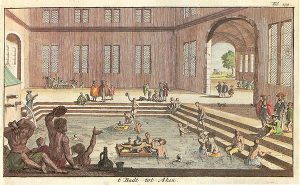 Roman and Greek Bathhouses paved the way for modern spas today. Heat therapy was integral to these communities in the form of hot spring bath and steam rooms. The bathhouse provided an opportunity to purify the body through intense sweating thus opening up the pores to detoxify the body of pollutants and promoting heightened states of health.
Roman and Greek Bathhouses paved the way for modern spas today. Heat therapy was integral to these communities in the form of hot spring bath and steam rooms. The bathhouse provided an opportunity to purify the body through intense sweating thus opening up the pores to detoxify the body of pollutants and promoting heightened states of health.
Purification of the body was the original intent behind the Roman and Greek bathhouse, but the ritual evolved into a social meeting place, where political decisions, business deals, and social gatherings occurred.
Governments and private contractors built bathhouses accessible to all social classes. These meccas of heat therapy were found throughout the Roman and Greek empire, from the smallest towns to the largest metropolises. Ancient peoples valued heat therapy as a necessary facet of life.
The Roman and Greek bathhouse was a cornerstone of society and shaped one of the most powerful civilization ever known. The investigation sauna history would not be complete without the reverent honoring of Roman and Greek tradition.
The Turkish Hammam
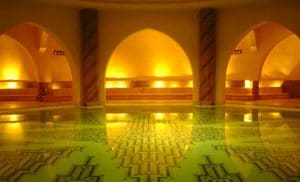 The Turkish Hammam was a bathhouse created inside ornate buildings and became a safe haven for spiritual and social communion. Their popularity grew during the Ottoman Empire to include the entire Islamic world. These communal bathhouses were segregated by gender. Inside the Haman was celebrated the great freedom of physical nudity.
The Turkish Hammam was a bathhouse created inside ornate buildings and became a safe haven for spiritual and social communion. Their popularity grew during the Ottoman Empire to include the entire Islamic world. These communal bathhouses were segregated by gender. Inside the Haman was celebrated the great freedom of physical nudity.
Participants of the Turkish Hammam began in hot air rooms to initiate deep states of relaxation. Following the hot air room sessions, participates would move into a room of hotter, dryer temperatures, and finally, purify the body with cool water. Similar to modern day spas, massage was available as was specified hair removal and other treatments to purify, relax and beautify the body.
Bathhouses of the Ottoman Empire were an integral aspect of the social community for women. The Turkish Hammam acted as a pillar of society and during their height in popularity if a husband barred his wife from participating in the bathhouse ritual it was grounds for divorce.
Modern Middle Eastern Islamic countries have since drawn away from the norm of this era and women have lost their fundamental right to the Haman. Nevertheless, history demonstrates the great value of ceremonial heat therapy on an entire demographic and culture.
The tradition of spiritual and physical purification of the Turkish Hammam spread into Europe and became a staple during the Victorian Era. The Victorian Turkish bath houses incorporated pools into their buildings so that after intense heat therapy, individuals could plunge themselves into cold bodies of water.
Turkish Hamans have been revered and featured in masterful oil paintings by Jean Auguste Dominique Ingres that can be found in the Louvre, Paris today. Bathhouses remain prevalent in Morocco, Turkey, and other Middle Eastern countries, but do not hold the same heightened place in society they once did during the Ottoman Empire.
The Sweat Lodge
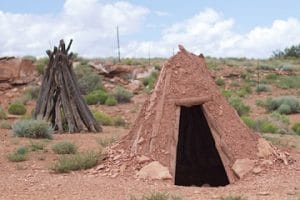 This profoundly ceremonious, spiritual tradition has been steeped in the culture of Native Americans, including South, Central, and North America for thousands of years. The Maori of New Zealand and aboriginal people of Australia also celebrate a rich tradition of sweat lodges. The specifics of sweat lodge practices vary from region to region, each offering unique language, songs, instruments, and individual rituals. They all celebrate the offering of perspiration in unison with prayer and ultimate communion with Spirit.
This profoundly ceremonious, spiritual tradition has been steeped in the culture of Native Americans, including South, Central, and North America for thousands of years. The Maori of New Zealand and aboriginal people of Australia also celebrate a rich tradition of sweat lodges. The specifics of sweat lodge practices vary from region to region, each offering unique language, songs, instruments, and individual rituals. They all celebrate the offering of perspiration in unison with prayer and ultimate communion with Spirit.
The sweat lodge reflects a paramount expression of devotion for indigenous people for many thousands of years and only in recent history has any written record been made. Led by well-trained elders, sweat lodge ceremonies permit participants to experience the mystical.
Typically dome-shaped, the sweat lodge, despite its name, does not resemble a ski lodge or any other larger concept of a lodge. It is smaller inside (a diameter of about 15 feet) and has the capacity to fit ten to fifteen participants. Sweat lodges are held together with clay, rocks, and grass. The particular construction depends upon the natural environment where it is built. The door is generally short and requires participants to bend over or find all fours to enter.
The sweat lodge is dark inside and hot rocks are imported to the center of the dome lodge. Water is then spilled over the rocks, creating steam to heat up the well-insulated unit.
Once all of the devoted participants are established inside the lodge, an elder of the community leads the ceremony through song and prayer. The darkness, heat, prayer, and music create an environment to unveil the curtain between the physical and spiritual. The expectation is that through physical purification, profound mystical experience transpires.
The sweat lodge recognizes the inextricable connection between spirit and body, while the heat fosters the health of the body through purification and opens the spirit to communion with the divine.
Many Cultures: One Intention
Egypt has a rich tradition of medicinal heat therapy for patients suffering from tumors and infections. Heat therapy was used to treat specific regions of the body as well as the whole body using hot springs and steam rooms.
Russia has a legendary history of thermal therapy using saunas born out of the Finnish tradition and steam rooms to promote profuse sweating followed by exposing the body to very cold temperatures.
Japan has used its natural hot springs for centuries to treat health disorders and to promote optimal health.
Indian Ayurvedic medicine has incorporated heat therapy in their healing modalities for thousands of years using a hot stone massage.
Laos is a country steeped in herbal sauna therapy. Every village features at least one sauna. The herbal saunas of Laos are particularly popular among women and are used to aid the healing process after childbirth. These saunas have become a sanctuary for women and a place of social networking and community.
A Jjimjilbang is a Korean bathhouse featuring traditional Korean Kiln saunas. In addition to the hot springs, saunas, and massage, the Jjimjilbangs, Korean for heat, also features therapeutic spaces with heated floors for deep healing. Participants complete their time in the Jjimjibangs by lying on a heated floor to solidify the experience.
Regardless of culture and geographical zoning or time in history, human beings have turned to heat as a therapeutic treatment mechanism to increase health and promote spiritual purification and union.
Collectively, humanity has used the most advanced technology available to create structures that intentionally promote copious sweating.
The First Electrical Sauna: The Birth of the Infrared
The advent of electricity in the late nineteenth century gave birth to the first infrared sauna. John Harvey Kellogg dedicated his life to holistic healing modalities including a well-balanced diet, colonics, regular exercise, and sauna therapy.
Mr. Kellogg recognized the profound healing effects of purification through intense sweating and wanted to improve upon the traditional sauna therapy being used. He turned to the first electrical light bulb and created his ‘Incandescent Light Baths’. Patients entered cabinet-like structures heated with exposed light bulbs that generated profuse sweating.
In addition to the prolific sweating, Kellogg noticed the profound impact of the exposure to light.
After being displayed at the 1893 World Fair in Chicago, Incandescent Light Baths created by Kellogg skyrocketed in popularity and were sold all over the world. The incandescent light bulbs were found to primarily emit infrared light that penetrated deeply into the skin membrane. This penetrative lighting was so effective in its ability to produce excessive sweating, and therefore detoxification protocol, that it became the forefather of the infrared sauna we know today.
The Evolution of the Modern Broad Spectrum Infrared Sauna
The Incandescent Light Baths created by Kellogg did not evolve much from the late nineteenth century until the 1960s when NASA took an interest in the variety of wavelengths created through the infrared. The discovery of the near, mid and far infrared wavelengths catapulted the sauna to its next evolutionary state.
In 1965 a Japanese doctor received the first patent to create a ceramic infrared sauna using far-infrared wavelengths. Until the late 1970s, Japanese doctors were the only known medical practitioners to use far infrared sauna treatment for their patients.
In 1979 the first broad spectrum infrared saunas became available to the public in the United States. In the last twenty years, heating systems have been honed to create optimal infrared wavelengths that promote comfort, safety, and ultimately profuse perspiration.
The Next Evolution
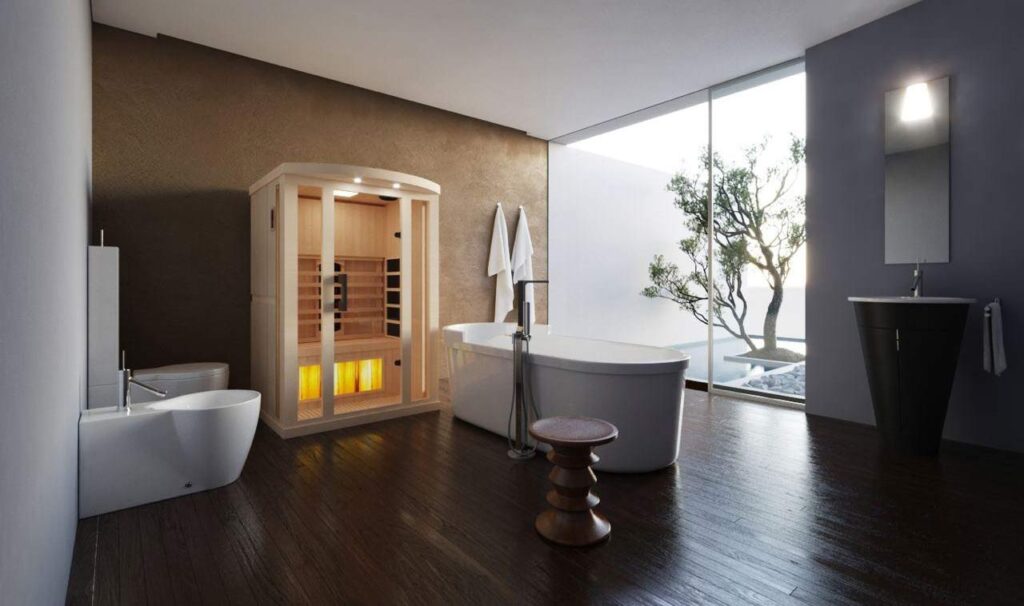 Many companies have capitalized on the incredible healing effects of the broad spectrum infrared sauna; quick to turn a profit, these brands have overlooked the harmful effects of EMF (electromagnetic radiation) exposure, so please be mindful to research each infrared sauna company thoroughly.
Many companies have capitalized on the incredible healing effects of the broad spectrum infrared sauna; quick to turn a profit, these brands have overlooked the harmful effects of EMF (electromagnetic radiation) exposure, so please be mindful to research each infrared sauna company thoroughly.
Today, infrared saunas successfully create the safest and most effective version of broad spectrum infrared sauna therapy with undetectable EMF emissions.
From dugouts in East Africa to the great bathhouses of the Roman and Greek Empires, the soul filled tradition of the Finnish sauna, the mystical Sweat Lodges of the indigenous peoples and the sanctuary space of the Turkish Hammam during the Ottoman Empire, infrared saunas are the next evolution in the history of heat therapy.
Sources:
1. http://www.globalhistorylab.com/uncategorized/sauna-and-bathing-in-global-history/
2. http://www.lymebook.com/history-of-sauna-therapy
3. https://www.thermaltherapy.org/ebusSFTM/societyinfo/whatisthermalmedicine.aspx
4. https://www.parksandrecbusiness.com/articles/2008/03/04/the-evolution-of-the-sauna
5. https://saunacloud.com/a-guide-to-the-history-of-infrared-saunas/
6. https://www.parksandrecbusiness.com/articles/2008/03/04/the-evolution-of-the-sauna
7. “The Evolution Of Us”, Netflix Documentary

